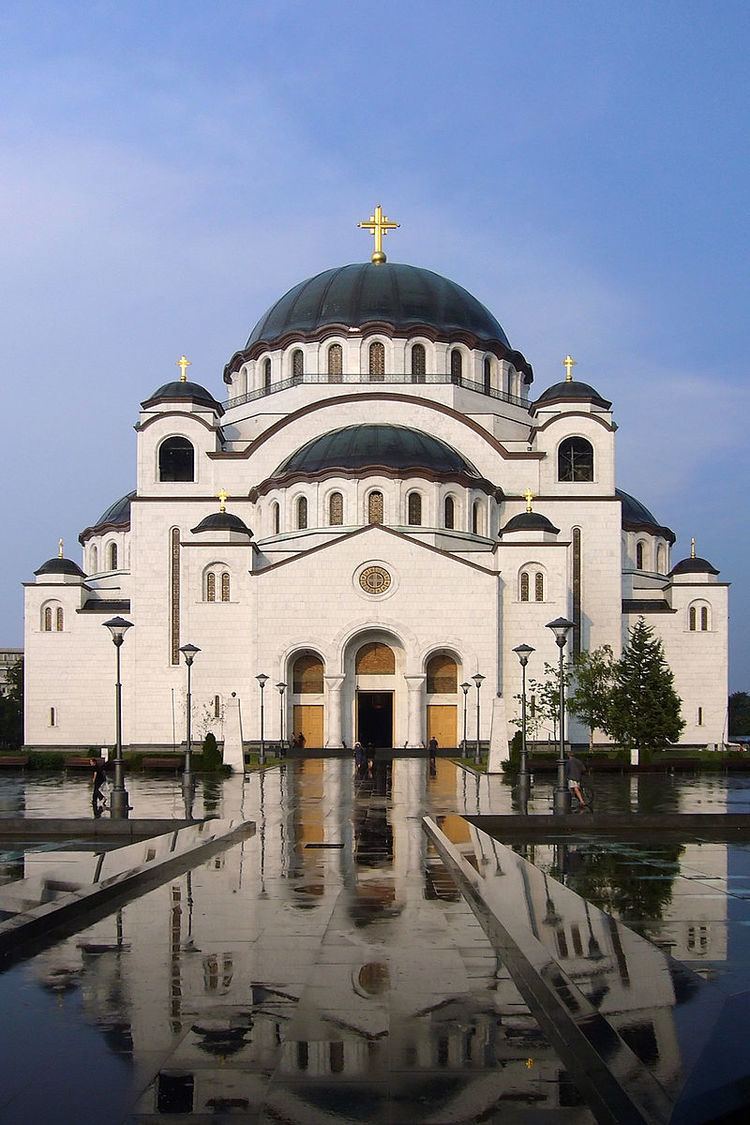Established 1931 | ||
 | ||
Language Church SlavonicSerbian Bishop Serbian Patriarch Irinej | ||
Archbishopric of Belgrade and Karlovci (Serbian Cyrillic: Архиепископија београдско-карловачка) is the central or patriarchal eparchy of the Serbian Orthodox Church, with seat in Belgrade, Serbia. The head of the eparchy is the Serbian Patriarch.
Contents
History of the eparchy, since 1920
In 1920, after the unification of all Serbian ecclesiastical provinces into one united Serbian Orthodox Church, old Eparchy of Syrmia with its seat in Sremski Karlovci came under direct administration of Archbishop of Belgrade who was also the Serbian Patriarch. Formal unification of two eparchies was completed in 1931 when Archbishopric of Belgrade was joined with the Eparchy of Syrmia into the Archbishopric of Belgrade and Karlovci. In that time, the city of Pančevo was transferred from Eparchy of Vršac to the Archeparchy of Belgrade and Karlovci. In 1947, Eparchy of Syrmia and Eparchy of Šumadija were excluded from the Archbishopric of Belgrade and Karlovci and were transformed into separate organizational units. The city of Pančevo was returned to the Eparchy of Banat. Although, the name of the Archbishopric of Belgrade and Karlovci includes the name of the town of Karlovci (Sremski Karlovci), this town is today part of the Eparchy of Syrmia and not of the Archbishopric of Belgrade and Karlovci.
Historical background, before 1920
Eparchy of Belgrade is one of the oldest ecclesiastical institutions in this part of Europe. Ancient Bishopric of Singidunum was an important ecclesiastical center of the late Roman Empire during 4th and 5th century. Its bishops Ursacius and Secundianus were actively involved in religious controversies over Arianism. That ancient bishopric finally collapsed after 584 when ancient Singidunum was finally destroyed by Avars.
After the Christianization of Slavs, eparchy was renewed as late as 9th century. First medieval Bishop of Belgrade who is known by name was Sergije in 878. Since 1018 it belonged to the Eastern Orthodox Archbishopric of Ohrid. At the end of 13th century, Belgrade became the capital city of Serbian king Stefan Dragutin and Eparchy of Belgrad came under jurisdiction of Serbian Orthodox Church. At the beginning of 15th century, during the rule of Serbian despot Stefan Lazarević, metropolitans of Belgrade were among most influential hierarchs of the Serbian Patriarchate. Belgrade fell under Turkish rule in 1521, but Serbian Patriarchate was renewed in 1557 with its seat in Peć. During 16th and 17th centuries, Serbian bishops of Belgrade were styled as "Metropolitans of Belgrade and Srem".
At the end of 17th century, regions of Belgrade and Srem were separated. In 1708, when autonomous Serbian Metropolitanate in Habsburg Monarchy was created, Eparchy of Srem became archdiocese of the Metropolitan, whose seat was in Sremski Karlovci. Eparchy of Srem remained part of Metropolitanate of Karlovci until 1920. On the other hand, after the abolition of Serbian Patriarchate in 1766, Eparchy of Belgrade came inder direct jurisdiction of the Patriarchate of Constantinople.
In 1831, Orthodox Church in Principality of Serbia gained its autonomy from the Patriarchate of Constantinople, and Belgrade became the seat of the Archbishop who was now Metropolitan of Serbia. In that time, territory of the archeparchy was very large and included regions of present-day eparchies of Šumadija and Braničevo.
In 1920, Metropolitanate of Serbia merged with other Serbian ecclesiastical provinces to form united Serbian Orthodox Church. In the same year, region of Braničevo was separated from the archeparchy and old Eparchy of Braničevo was restored. In 1947, region of Šumadija was also separated from the archeparchy and new Eparchy of Šumadija was created. Since then, the archbishopric was reduced to the inner limits of the City of Belgrade.
Monasteries
There are 12 monasteries within the Archbishopric.
Heads
During the long history of the ecclesiastical seat of Belgrade, many bishops, metropolitans, archbishops and finally patriarchs were seated on the throne of this eparchy.
